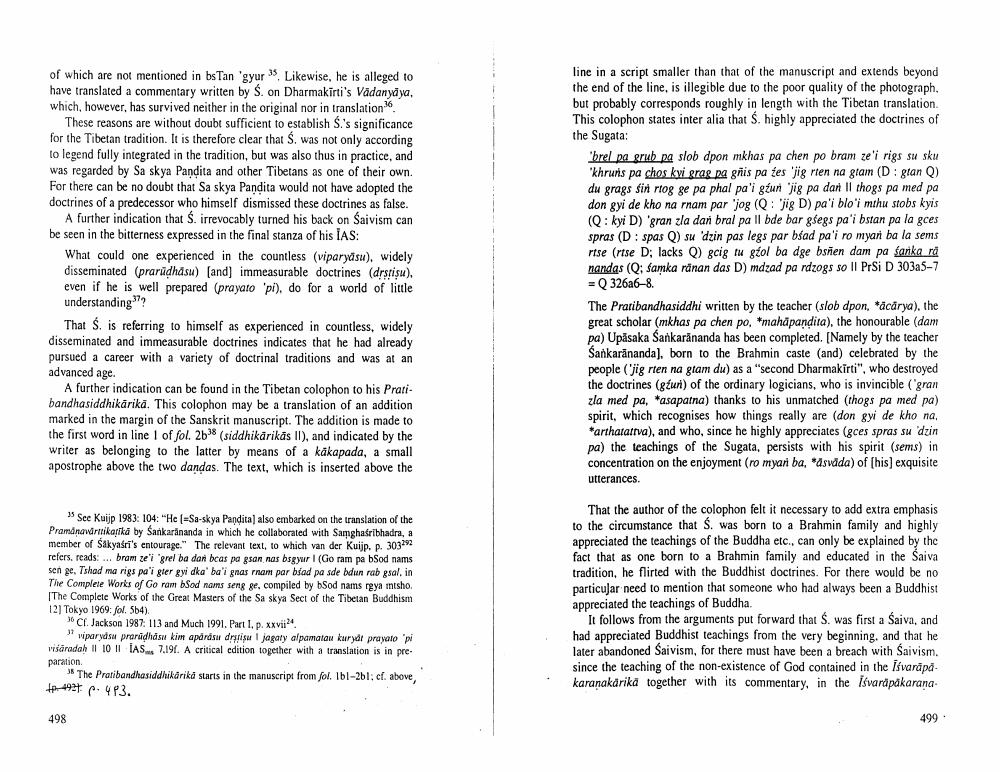Book Title: On Dates And Works Of Sankaranandana Author(s): Helmut Krasser Publisher: Helmut Krasser View full book textPage 6
________________ of which are not mentioned in bsTan 'gyur 35. Likewise, he is alleged to have translated a commentary written by S. on Dharmakirti's Vädanyaya, which, however, has survived neither in the original nor in translation These reasons are without doubt sufficient to establish S.'s significance for the Tibetan tradition. It is therefore clear that S. was not only according to legend fully integrated in the tradition, but was also thus in practice, and was regarded by Sa skya Pandita and other Tibetans as one of their own. For there can be no doubt that Sa skya Pandita would not have adopted the doctrines of a predecessor who himself dismissed these doctrines as false. A further indication that Ś. irrevocably turned his back on Saivism can be seen in the bitterness expressed in the final stanza of his IAS: What could one experienced in the countless (viparyasu), widely disseminated (prarüḍhasu) [and] immeasurable doctrines (drstisu). even if he is well prepared (prayato 'pi), do for a world of little understanding 37? That S. is referring to himself as experienced in countless, widely disseminated and immeasurable doctrines indicates that he had already pursued a career with a variety of doctrinal traditions and was at an advanced age. A further indication can be found in the Tibetan colophon to his Pratibandhasiddhikarika. This colophon may be a translation of an addition marked in the margin of the Sanskrit manuscript. The addition is made to the first word in line 1 of fol. 2b38 (siddhikärikäs II), and indicated by the writer as belonging to the latter by means of a kakapada, a small apostrophe above the two dandas. The text, which is inserted above the 35 See Kuijp 1983: 104: "He [-Sa-skya Pandita] also embarked on the translation of the Pramanavarttikatika by Sankarananda in which he collaborated with Samgharibhadra, a member of Sakyasri's entourage." The relevant text, to which van der Kuijp. p. 303292 refers, reads:... bram ze'i 'grel ba dan beas pa gsan nas bsgyur I (Go ram pa bSod nams sen ge, Tshad ma rigs pa'i gter gyi dka' ba'i gnas rnam par biad pa sde bdun rab gsal, in The Complete Works of Go ram bSod nams seng ge, compiled by bSod nams rgya mtsho. The Complete Works of the Great Masters of the Sa skya Sect of the Tibetan Buddhism 12] Tokyo 1969: fol. 5b4). 36 Cf. Jackson 1987: 113 and Much 1991. Part 1, p. xxvii24 3 viparydsu prarüḍhāsu kim apárásu drşişu 1 jagaty alpamatau kuryat prayato 'pi visäradaḥ 11 10 11 IAS 7.19f. A critical edition together with a translation is in pre paration. J8The Pratibandhasiddhikarika starts in the manuscript from fol. 1b1-2bl; cf. above, tp-4924 p. 493. 498 line in a script smaller than that of the manuscript and extends beyond the end of the line, is illegible due to the poor quality of the photograph. but probably corresponds roughly in length with the Tibetan translation. This colophon states inter alia that Ś. highly appreciated the doctrines of the Sugata: 'brel pa grub pa slob dpon mkhas pa chen po bram ze'i rigs su sku "khruns pa chos kvi grag pa gñis pa tes 'jig rien na gram (D: gtan Q) du grags sin rtog ge pa phal pa'i gźun jig pa dan II thogs pa med pa don gyi de kho na rnam par 'jog (Q: 'jig D) pa'i blo'i mthu stobs kyis (Q: kyi D) 'gran zla dan bral pa II bde bar gśegs pa'i bstan pa la gces spras (D: spas Q) su 'dzin pas legs par bśad pa'i ro myan ba la sems rtse (rtse D; lacks Q) gcig tu gźol ba dge bsñen dam pa sanka rä nandas (Q: samka ränan das D) mdzad pa rdzogs so Il PrSi D 303a5-7 =Q 326a6-8. The Pratibandhasiddhi written by the teacher (slob dpon, *äcārya), the great scholar (mkhas pa chen po, *mahäpaṇḍita), the honourable (dam pa) Upāsaka Šankarānanda has been completed. [Namely by the teacher Sankarananda], born to the Brahmin caste (and) celebrated by the people ('jig rten na gtam du) as a "second Dharmakirti", who destroyed the doctrines (gun) of the ordinary logicians, who is invincible ('gran zla med pa, *asapatna) thanks to his unmatched (thogs pa med pa) spirit, which recognises how things really are (don gyi de kho na. *arthatattva), and who, since he highly appreciates (gces spras su 'dzin pa) the teachings of the Sugata, persists with his spirit (sems) in concentration on the enjoyment (ro myari ba, *äsvada) of [his] exquisite utterances. That the author of the colophon felt it necessary to add extra emphasis to the circumstance that Ś. was born to a Brahmin family and highly appreciated the teachings of the Buddha etc., can only be explained by the fact that as one born to a Brahmin family and educated in the Šaiva tradition, he flirted with the Buddhist doctrines. For there would be no particular need to mention that someone who had always been a Buddhist appreciated the teachings of Buddha. It follows from the arguments put forward that S. was first a Śaiva, and had appreciated Buddhist teachings from the very beginning, and that he later abandoned Saivism, for there must have been a breach with Saivism. since the teaching of the non-existence of God contained in the Isvarāpākaraṇakärikä together with its commentary, in the Isvarapakaraṇa 499.Page Navigation
1 ... 4 5 6 7 8 9 10 11
